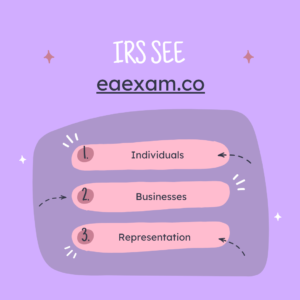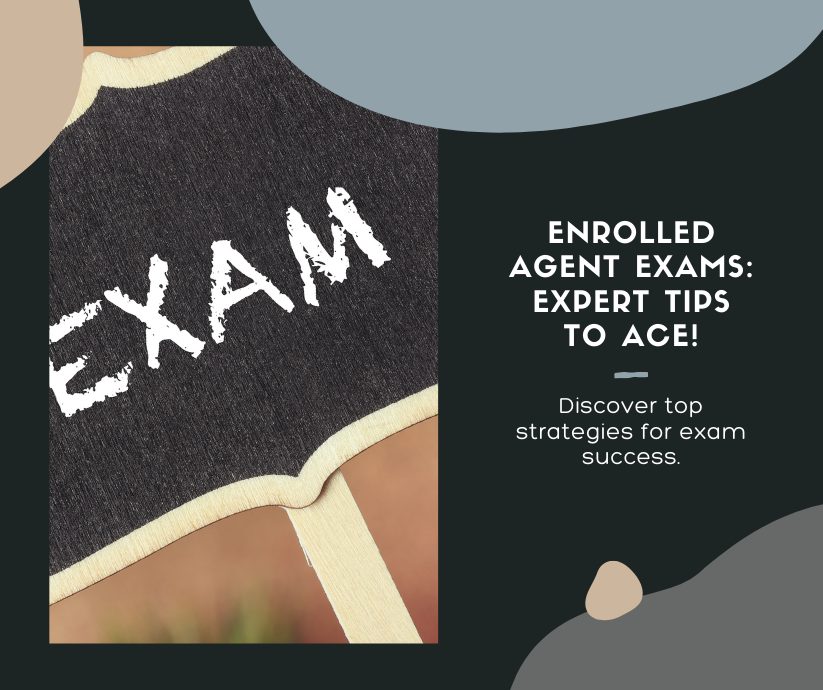If you are looking to become an Enrolled Agent with the IRS, you first have to pass a special examination. The Special Enrollment Examination (SEE) is designed to evaluate your knowledge of taxes and tax law. To help you determine if this exam is the right choice for you, let’s take a look at the subjects covered on the SEE. This blog post provides a breakdown of the topics included on the SEE so that you can make an informed decision about whether or not it’s the right path for you.
The SEE is a three-part examination that covers representation, individual taxation, and business taxation.
Special Enrollment Examination 1: Individual Taxation
The individual taxation section of the IRS Special Enrollment Examination (SEE) covers a wide range of topics related to personal taxes. This includes filing status, exemptions, deductions, and credits. The examination also covers a variety of tax-related topics such as estate and gift taxes, self-employment taxes, and payroll taxes.
Special Enrollment Examination 2: Business Taxation
Part 2 of the Special Enrollment Examination, also known as the “Business” portion, tests a candidate’s knowledge of tax-related business concepts and practices. This section of the exam covers topics such as accounting methods, business entities, business income and deductions, and retirement plans. Candidates are required to demonstrate a thorough understanding of the tax rules and regulations surrounding these topics in order to pass the IRS EA exam.
Special Enrollment Examination 3: Representation, Practice and Procedures
The “Representation, Practice, and Procedures” portion, tests a candidate’s knowledge of tax practice and procedure. This section of the exam covers topics such as practice before the IRS, tax returns and documentation, penalties and interest, and ethical practices. Candidates are required to demonstrate a thorough understanding of the rules and regulations governing tax practice and procedure in order to pass the exam. Additionally, candidates are expected to have knowledge of the professional standards and conduct expected of enrolled agents.
Ethics and Professional Responsibilities
There are a number of ethical and professional responsibilities that tax preparers need to be aware of. The most important of these is the requirement to maintain confidentiality when dealing with clients’ financial information. Tax preparers also need to be honest and transparent in their dealings with clients, and avoid any potential conflict of interest. They should also make sure that they are up to date on all relevant tax laws and regulations.

Examination Topics Overview
The examination is divided into three parts. Each part lasts 3.5 hours (not including the pre-examination tutorial and post-examination survey). There is an on-screen timer that indicates how much time remains. In addition to the 85 multiple-choice questions that are scored in each part, there are 15 experimental questions that are not scored.
SEE 1: Part 1 — Individuals
- Preliminary Work with Taxpayer Data – 14 questions
- Income and Assets – 17 questions
- Deductions and Credits – 17 questions
- Taxation – 15 questions
- Advising the Individual Taxpayer – 11 questions
- Specialized Returns for Individuals – 12 questions
SEE 2: Part 2 — Businesses
- Business Entities and Considerations– 30 questions
- Business Tax Preparation – 37 questions
- Specialized Returns and Taxpayers – 18 questions
SEE 3: Part 3 — Representation, Practices and Procedures
- Practices and Procedures – 26 questions
- Representation before the IRS – 25 questions
- Specific Areas of Representation – 20 questions
- Filing Process – 14 questions
Special Enrollment Examination Topics Detail

Special Enrollment Examination 1: Part 1 — Individuals
Domain 1: Preliminary Work and Taxpayer Data | 14 Questions
1.1. Preliminary work to prepare tax returns
- Use of prior years’ returns for comparison, accuracy, and carryovers for current year’s return
- Taxpayer personal information (e.g., date of birth, marital status, dependents, identity protection PIN, state issued photo ID)
- Residency status and/or citizenship (e.g., , visas, green cards, resident alien or non-resident alien, ITIN)
- Filing requirements and due date
- Taxpayer filing status
- Sources of worldwide taxable and non-taxable income (e.g., interest, wages, business, sales of property, dividends, rental income, flow-through entities, alimony received)
- Sources of applicable exclusions and adjustments to gross income (e.g., foreign earned income exclusion, retirement plans, HSAs, alimony paid, health insurance, self-employment tax)
- Sources of applicable deductions (e.g., itemized, standard)
- Qualifications for dependency
- Sources of applicable credits (e.g., education, foreign tax, child and dependent care, credit for other dependents, child tax credit)
- Sources of tax payments and refundable credits
- Previous IRS correspondence with taxpayer
- Additional required returns to be filed, and taxes paid (e.g., employment, gifts, international information returns, and other information returns)
- Special filing requirements (e.g. foreign income, presidentially declared disaster areas, injured spouse)
- Foreign account and asset reporting (e.g., FBAR, Form 8938)
- Minor children’s unearned income (“Kiddie” tax)
- ACA requirements (e.g., , total household income, premium tax credit, household size)
Domain 2: Income and Assets | 17 Questions
2.1. Income
- Taxability of wages, salaries and other earnings
- Interest Income (e.g., taxable and non-taxable)
- Dividends and other distributions from mutual funds, corporations, and other entities -Personal property rental
- Gambling income and allowable deductions (e.g., Form W-2G, documentation) -Tax treatment of cancellation of debt (e.g., Form 1099C, foreclosures, insolvency)
- Tax treatment of a U.S. citizen/resident with foreign income (e.g., tax treaties, Form 1116, Form 2555, Form 3520, Form 5471)
- Other income (e.g., scholarships, barter income, hobby income, alimony, non-taxable combat pay, unearned income, taxable recoveries, NOL, illegal income)
- Constructive receipt of income
- Constructive dividends (e.g., payments of personal expenses from a business entity) -Passive income and loss
- Pass-through income (e.g., Schedule K-1, income, deductions, basis, qualified business income (QBI) items)
- Royalties and related expenses
- State/local income tax refund and other itemized deduction recoveries
- 1099 MISC, 1099 NEC, 1099 K reporting, irregularities, and corrections
2.2. Retirement income
- Basis in a traditional IRA (Form 8606)
- Comparison of and distributions from traditional and Roth IRAs
- Distributions from qualified and non-qualified plans (e.g., pre-tax, after-tax, rollovers, Form 1099R, qualified charitable distribution)
- Excess contributions and tax treatment (e.g., penalties)
- Penalties and exceptions on premature distributions from qualified retirement plans and IRAs -Prohibited transactions and tax consequences
- IRA conversions and recharacterization (Form 8606)
- Required minimum distributions
- Loans from qualified plans
- Taxability of Social Security and Railroad Retirement benefits
- Inherited retirement accounts
- Foreign pensions and retirement income
2.3. Property, real and personal
- Sale or disposition of property including depreciation recapture rules and 1099A
- Capital gains and losses (e.g., netting effect, short-term, long-term, mark-to-market, virtual currency)
- Basis of assets (e.g., purchased, gifted or inherited)
- Basis of stock after stock splits and/or stock dividends (e.g., research, schedules, brokerage re cords)
- Publicly traded partnerships (PTP) (e.g., sales, dispositions, losses)
- Sale of a personal residence (e.g., IRC sec 121 exclusions)
- Installment sales (e.g., related parties, original cost, date of acquisition, possible recalculations and recharacterization)
- Options (e.g., stock, commodity, ISO, ESPP)
- Like-kind exchange
- Non-business bad debts
- Investor versus trader
2.4. Adjustments to Income
- Self-employment tax
- Retirement contribution limits and deductibility (e.g., earned compensation requirements) -Health savings accounts
- Other adjustments to income (e.g., student loan interest, alimony, moving expenses for active military, write-in adjustments)
- Self-Employed Health Insurance
Domain 3: Deductions and Credits | 17 Questions
3.1. Itemized deductions and QBI
- Medical, dental, vision, long-term care expenses
- Various taxes (e.g., state and local, personal property, real estate)
- Interest expense (e.g., mortgage interest, investment interest, tracing rules, points, indebtedness limitations)
- Charitable contributions (e.g., cash, non-cash, limitations, documentation required) -Nonbusiness casualty and theft losses
- Other itemized deductions
- Itemized deductions for Form 1040-NR
- Qualified Business Income (QBI) deduction
3.2. Credits
- Child and dependent care credit
- Child tax credit and credit for other dependents
- Education credits
- Foreign tax credit
- Earned income tax credit (e.g., paid preparer’s earned income credit checklist, eligibility and disallowance)
- Adoption credits (e.g., carryovers, limitations, special needs)
- ACA premium tax credit
- Other credits (refundable and non-refundable) (e.g., health coverage tax credit, energy credits, Retirement savings contribution credit)
Domain 4: Taxation | 15 Items
4.1. Taxation
- Alternative minimum tax and credit for prior year
- Household employees
- Underpayment penalties and interest
- Self-employment tax
- Excess Social Security withholding
- Tax provisions for members of the clergy
- Tax provisions for members of the military
- Income in respect of decedent
- Net investment income tax
- Additional Medicare tax
- Uncollected Social Security and Medicare tax
- Other taxes (e.g., first time homebuyer credit repayment)
Domain 5: Advising the individual taxpayer | 11 Questions
5.1. Advising the Individual Taxpayer
- Reporting obligations for individuals (e.g., 1099, bartering, cash)
- Property sales (e.g., homes, stock, businesses, antiques, collectibles)
- Education planning (e.g., lifetime learning credit, IRC section 529 plans)
- Estate planning (e.g., gift versus inheritance, trusts, family partnerships, charitable giving, long term care, life insurance)
- Retirement planning (e.g., annuities, IRAs, employer plans, early retirement rules, required minimum distribution, beneficiary ownership, charitable distributions from an IRA)
- Marriage and divorce (e.g., divorce settlement, common-law, community property, alimony)
- Items that will affect future/past returns (e.g., carryovers, net operating loss, Schedule D, Form 8801, negative QBI carryover)
- Injured spouse
- Innocent spouse
- Estimated tax and penalty avoidance (e.g., mid-year estimated tax planning)
- Adjustments, deductions, and credits for tax planning (e.g., timing of income and expenses) -Character of transaction (e.g., use of capital gain rates versus ordinary income rates)
- Advantages and disadvantages of MFJ/MFS/HOH filing statuses in various scenarios (e.g., joint and several liability)
- Conditions for filing a claim for refund (e.g., amended returns)
- Penalty of perjury
Domain 6: Specialized Returns for Individuals | 11 Questions
6.1. Estate Tax
- Gross estate, taxable estate (calculations and payments), unified credit
- Jointly held property
- Marital deduction and other marital issues (e.g., portability election)
- Life insurance, IRAs, and retirement plans
- Estate filing requirements and due dates (e.g., Form 706: Form 1041)
6.2. Gift Tax
- Gift-splitting
- Annual exclusion
- Unified credit
- Effect on estate tax (e.g., Generation skipping transfer tax)
- Filing requirements (e.g., Form 709)
6.3.International Information Reporting
- Filing and reporting requirements and due dates (e.g., FBAR, Form 8938, Form 8865, Form 5471, Form 3520)
- Covered accounts (e.g., FBAR, Form 8938)
- Potential penalties (e.g., failure to file, underreporting, substantially incomplete, statute of limitations, reduction of tax attributes)
- Distinctions between FBAR and Form 8938 requirements
Special Enrollment Examination 2: Part 2 — Businesses
Domain 1: Business Entities and Considerations | 30 Questions
1.1. Business Entities
- Sole proprietorships
- Partnerships and qualified joint ventures (QJV)
- Corporations
- S corporations
- LLCs
- Tax-exempt entities and associations
- Entity type default classifications and elections
- Employer identification number
- Accounting periods (tax year)
- Reporting requirements (e. g., Forms W-2, W-4, Form 1099)
- Hobby versus business determination and loss limitations
1.2. Partnerships
- Partnership income, expenses, distributions, and flow-through (e. g., self-employment income) -Family partnerships
- Partner’s dealings with partnership (e. g., exchange of property, guaranteed payments)
- Contribution of property and/or services to a partnership (e. g., partnership’s basis, property subject to indebtedness)
- Basis of partner’s interest
- Disposition of partner’s interest
- Partnership formation (e. g., partnership agreement, general vs limited partners, capital contributions)
- Dissolution of partnership (e. g., sale, death of partner)
- Filing requirements, due dates, penalties, and audit notice requirements
- Partnership cancellation of debt
- Partnership level audit and opt-out
1.3. Corporations in general
- Filing requirements, due dates, and penalties
- Earnings and profits
- Shareholder dividends, distributions, and recognition requirements
- Special deductions and credits (e. g., dividends received deductions, charitable deduction) -Liquidations and stock redemptions
- Accumulated earnings tax
- Estimated tax payments
- Corporate minimum tax credit
1.4. Forming a corporation
- Services rendered to a corporation in return for stock
- IRC section 351 exchange
- Transfer and/or receipt of money or property in addition to corporate stock -Transfer of property subject to indebtedness
- Controlled groups
- Closely held corporations
1.5. S corporations
- Requirements to qualify (e. g., qualifying shareholders)
- Election procedure
- Income, expenses and separately stated items
- Treatment of distributions
- Shareholder’s basis (e. g., loan basis, distributions and losses in excess of basis, services for stock)
- Revocation, termination and reinstatement
- Debt discharge
Domain 2: Business Tax Preparation | 37 Questions
2.1. Business Income
- Gross receipts and other income
- Cost of goods sold (e. g., inventory practices, expenditures included, uniform capitalization rules)
- Net income/loss and at-risk limitations
- Cancellation of business debt
2.2. Business expenses, deductions and credits
- Officers and employees’ compensation (e. g., deductibility, fringe benefits, rules of family employment, statutory employee, necessary and reasonable)
- Business rental deduction, including self-rentals
- Depreciation, amortization (start-up and organizational cost), IRC section 179, depletion, bonus depreciation, and correcting errors
- Business bad debts
- Business travel, meals, and gift expenses
- Vehicle use and expenses
- Interest expense
- Insurance expense
- Taxes (e. g., deductibility of taxes, assessments, and penalties; proper treatment of sales taxes paid, excise)
- Employment taxes
- Casualties, thefts, and condemnations
- Qualified business income(QBI) (e.g., SSTB, calculations, phase out, UBIA)
- Eligibility and deductibility of general business credits (e. g., disabled access credit, R & D credit, small business healthcare tax credit, foreign tax credit)
- Net operating loss deduction
- Home office
2.3. Business assets
- Basis of assets
- Disposition of property or assets
- Like kind exchange
- Converted property
- Capitalization and repair regulations (e. g., elections)
2.4. Analysis of financial records
- Proper business type, the use of classification codes, and year to year comparison -Income statement
- Balance sheet (e. g., proofing beginning and ending balances, relationship to income statement and depreciation)
- Method of accounting and changes (e. g., accrual, cash, hybrid, Form 3115)
- Depreciation recovery (e. g., recapture, IRC sec 280F)
- Pass-through activity (e. g., K-1, separately stated items, non-deductible expenses) -Reconciliation of tax versus books (e. g., M-1, M-2, M-3)
- Related party activity
- Loans to and from owners
2.5. Advising the business taxpayer
- Reporting and filing obligations (e. g., extended returns and potential penalties, international information returns, Form 1099 series, Form 8300)
- Payments and deposit obligations (e. g., employment tax, excise tax)
- Record-keeping requirements (e. g., mileage log, accountable plans)
- Selection of business entity (e. g., benefits and detriments)
- Comingling (e. g., personal usage of business accounts, separation of business and personal accounts)
- Advice on accounting methods and procedures (e. g., explanation of requirements) -Transfer of property in or out of the business
- Life cycle of the business (e. g., formation, dissolution)
- Type of industry (e. g., specified service business owners)
- Worker classification (e.g., independent contractor versus employee, outside sales, full-time versus part-time)
- Deductions and credits for tax planning (e.g., timing of income and expenses, NOL, depreciation versus IRC section 179 versus bonus depreciation)
- ACA compliance
Domain 3: Specialized Returns and Taxpayers | 18 Questions
3.1. Trust and estate income tax
- Trust types (e. g., simple/complex, grantor, irrevocable, tax shelters, foreign)
- Distributable net income and accounting income
- Exclusions, exemptions, and deductions
- Fraudulent trusts
- Income (e. g., allocations, corpus versus income)
- Separately stated items (e.g., items reported on the K-1)
- Filing requirements, tax years, and penalties
3.2. Exempt organizations
- Qualifying for and maintaining tax-exempt status (e. g., IRC 501(c))
- Applying for IRS tax-exempt status (e. g., Form 1023, Form 1024)
- Filing requirements (e. g., Form 990 series)
- Unrelated business taxable income
3.3. Retirement plans
- Employer and employee contributions
- Reporting requirements
- Plans for self-employed persons (e. g., SEP and SIMPLE)
- Prohibited transactions
- Qualified and non-qualified plans
- Non-discrimination rules
3.4. Farmers
- Farm income (e.g., livestock, crop insurance proceeds, subsidies, patronage dividends, conservation payments)
- Depreciation for farmers
- Disaster-area provisions (e.g., drought, flood, other weather-related conditions) -Farm rental (e.g., Form 4835)
- Farm tax computation (e.g., Schedule J, Schedule SE, estimated tax)
3.5 Rental Property
- Real estate professional qualifications
- Commercial rentals versus residential rentals
- Mixed used property/vacation home
- Passive loss limitation (e.g., special $25,000 allowance, MAGI limits)
- Rental income (e.g., deposits, pre-paid rent, not rented for profit)
- Rental expenses (e.g., allocation between personal and rental, repair versus capitalized)
Special Enrollment Examination 3: Part 3 — Representation, Practices and Procedures
Domain 1: Practices and Procedures | 26 Questions
1.1. Practice before the IRS
- What constitutes practice before the IRS
- Categories of individuals who may practice and extent of practice privileges
1.2. Requirements for Enrolled Agents
- Information to be furnished to the IRS
- Omission or error on return, document, or affidavit
- Rules for employing or accepting assistance from former IRS employees or disbarred/suspended persons
- Rules for restrictions on advertising, solicitation and fee information
- Rules regarding fees (e.g., contingent, unconscionable)
- Due diligence requirements
- Conflict of interest
- Rules for refund check negotiation
- Standards for written advice, covered opinions, tax return positions and preparing returns -Continuing education requirements
- Enrollment cycle and renewal
- Rules for prompt disposition of matters before the IRS
- Rules for returning a client’s records and documents
- PTIN requirements
- Practitioner supervisory responsibilities
1.3. Sanctionable acts
- Incompetence and disreputable conduct
- Sanctions imposed by the Office of Professional Responsibility
- Frivolous submissions (returns and documents)
- Fraudulent transactions (e.g., badges of fraud)
1.4. Rules and penalties
- Assessment and appeal procedures for preparer penalties
- Types of penalties (e.g., negligence, substantial understatement, overvaluation)
- Furnishing a copy of a return to a taxpayer
- Signing returns and furnishing identifying numbers
- Keeping copies or lists of returns prepared
- Employees engaged or employed during a return period (e.g., IRC section 6060) -Preparer due diligence penalties
Domain 2: Representation before the IRS | 25 Questions
2.1. Power of attorney
- Purpose of power of attorney
- Signature authority (e.g., extension of assessment period, closing agreement) -Authority granted by taxpayer
- Limitations on signing tax returns on behalf of taxpayer
- Proper completion of power of attorney (Form 2848)
- Alternate forms of power of attorney (durable)
- Rules for client privacy and consent to disclose
- Distinctions between power of attorney (Form 2848) and tax information authorization (Form 8821)
- Requirements to be met when changing or dropping representatives or withdrawal of representative
- Purpose of a Centralized Authorization File (CAF) number
- Conference and practice requirements (Publication 216)
2.2. Building the taxpayer’s case-Preliminary work
- Identification of tax issue(s) with supporting details
- Potential for criminal aspects
- Competence, expertise, and time to handle issue
- Conflict of interest in regards to representation
- Transcripts from IRS (e.g., access to and use of e-services)
2.3. Taxpayer financial situation
- Taxpayer’s ability to pay the tax (e.g., installment agreements, offer in compromise, currently not collectible)
- General financial health (e.g., bankruptcy, lawsuits, garnishments, cash flow, assets, and insolvency)
- Third-party research (e.g., property assessment for taxes, asset values, state and local tax information)
- Discharge of the tax liability in bankruptcy
- IRS Collection Financial Standards
2.4. Supporting documentation
- Financial documents and expense records (e.g., cancelled checks or equivalent, bank statements, credit card statements, receipts, brokerage records)
- Legal documents (e.g., birth certificate, divorce decrees, lawsuit settlements) -Prior and subsequent tax returns
- Other substantive and contemporaneous documentation (e.g., corporate minutes) -Business entity supporting documents (e.g., partnership agreement, corporate bylaws)
2.5. Legal authority and references
- Internal Revenue Code and income tax regulations
- Revenue rulings and revenue procedures
- Case law
- IRS forms, instructions, and publications
- Private letter ruling
- Internal Revenue Manual
- Authoritative versus non-authoritative source material
- Tax treaties
2.6. Related issues
- Statute of limitations
- Post-filing correspondence (e.g., math error notices, under-reporting notices) Deadlines and timeliness requirements
- Third-party correspondence (e.g., witness communications, employment records) -Freedom of Information Act (FOIA) requests
- Tax avoidance vs tax evasion
- Tax return disclosure statements
- Taxpayer Advocate Service (e.g., criteria for requesting assistance)
- Taxpayer identity Theft
- Judicial levels of representation beyond the scope of EA representation
Domain 3: Specific Areas of Representation | 20 Questions
3.1.Representing a taxpayer in the collection process
- Extension of time to pay (e.g., Form 1127)
- Installment agreements
- Offer in compromise
- Collection appeals program (e.g., denial of installment agreements, discharge applications) -Collection appeals and due process (e.g., lien, levy, and Form 12153)
- Adjustments to the taxpayer’s account (e.g., abatements and refund offsets) -Requesting an audit reconsideration (e.g., documents and forms)
- Representing a decedent
- Collection notice and Notice of Federal Tax Lien
- Levy and seizure of taxpayer’s property
- Currently Not Collectible (e.g., reasons and reactivation)
- IRS Collection Summons (e.g., purposes)
- Collections statute of limitations
- Trust fund recovery penalty
- Amended returns and claims for refund (e.g., Form 1040X, Form 843, effect on statute of limitations)
- Passport revocation
3.2. Penalties and/or interest abatement
- Penalties subject to abatement
- Basis for having penalties abated or refunded
- Basis for having interest abated or refunded
- Interest recalculation
- Procedures for requesting abatement
3.3. Representing a taxpayer in audits/examinations
- IRS authority to investigate
- Limited practitioner privilege (e.g., IRC section 7525)
- Verification and substantiation of entries on the return
- IRS authority to fix time and place of investigation
- Steps in the process (e.g., initial meeting, submission of IRS requested information) -Interpretation and analysis of revenue agent report (RAR) (e.g., 30-day letter) -Interpretation and analysis of CP-2000 notice and correspondence audits -Explanations of taxpayer options (e.g., agree or appeal)
- Taxpayer’s burden of proof
3.4. Representing a taxpayer before appeals
- Right to appeal Revenue Agent findings
- Request for appeals consideration (e.g., preparation, elements contained) -Enrolled Agent appearance at appeals conference
- Settlement function of the appeals process
- Issuance of 90-day letter
Domain 4: Filing Process | 14 Questions
4.1. Accuracy
- Reliance on software (e.g., review of results)
- Miscalculations and recognition of duplicate entries
4.2. Record maintenance
- Length of time to retain returns and records
- Data security (e.g., electronic, systems, paper)
4.3. Electronic filing
- Application process to be an e-file provider (e.g., e-services, EFIN)
- E-file mandate and exceptions (Form 8948)
- Advertising standards
- Definition and responsibilities of an ERO
- Levels of infractions
- Compliance requirements to continue in program
- EFIN revocation appeal process
- E-file authorization and supporting documentation (e.g., Form 8879 and Form 8453) -Rejected returns and resolution (e.g., client notification, IP PIN)







